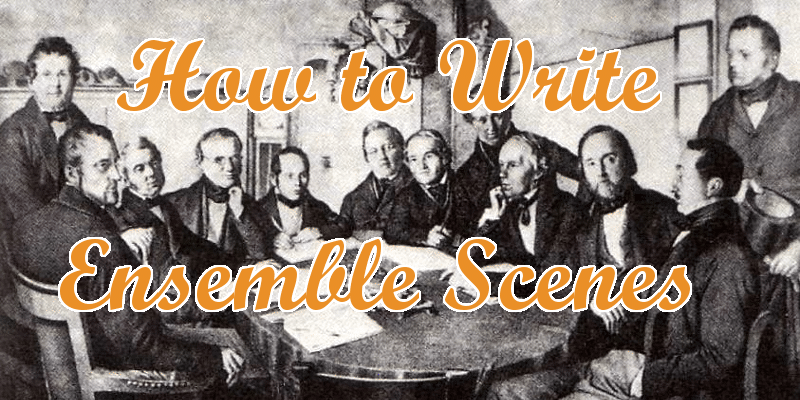
Writing a scene with one character is simple. Two isn’t much harder, and introduces the possibility of conversation. Even three characters in a single scene leaves room for everyone to breathe. But what do you do when the number gets higher? How do you keep a scene with five, six, or even ten characters from devolving into chaos?
Let’s take a look at three methods for handling a six-way argument, a common type of problem in an ensemble scene.
Method 1: Taking Turns
In a real life argument, you’d have people talking over one another, cutting each other off, and having side arguments that may only concern one or two participants. One way to handle this in print is to never have any more than two people arguing at the same time. While all six may end up participating throughout the scene, consider it a tag-team wrestling match, where only two are allowed in the ring at once. Then over the course of the argument, have the pair shift from A vs. B to B vs. C, and then on to C vs. D, and so forth. You can vary it as well, so that A vs. B leads to B vs. C, then back to A vs. B again, or you can swap out both and have D argue with A.
Example:
“The 3% tax hike is too high,” said A.
B grumbled. “I don’t think it’s high enough.”
“You didn’t think so last year,” A countered.
C raised a finger. “Yes, but last year we didn’t have a new bridge to pay for.”
“I think we can pay for the bridge without taxes going up a whole 3%,” said A.
D knocked over his chair as he stood. “You people and your stupid bridge!”
Method 2: Sidelining
While you can have a number of people in a scene, not all of them have to have an active presence. Maybe certain characters are there for plot reasons, but they won’t contribute to the conversation as seen by the reader. Maybe for the sake of brevity some of their dialogue is summarized.
Example:
Coach Miller looked over the downcast faces of her team. “Hey, we gave it our best and came in second in the whole state. That’s nothing to be ashamed of.”
“It’s my fault,” said Lucy, the team’s starting pitcher. “I gave up those four runs in the first, and—”
“And nothing,” Coach Miller snapped. “This is a team game, and when we tied the score in the eighth, it was a new ballgame.”
Lucy’s teammates spoke up one by one, claiming their part in the loss. Jackie had that error that led to the unearned runs. Beth struck out with the bases loaded in the seventh. Jess bobbled the double-play ball in the ninth that could have sent the game to extra innings. Even Krista, with her two-run homer to tie it, could have done better than three strikeouts in her other at-bats.
“See?” Coach Miller said. “In any loss there’s always something everyone could have done differently. Now, the bus is waiting. Grab your gear and let’s head home.”
Method 3: Embrace the Chaos
Many times, the point of a big argument is to portray the chaos of a situation. Say a heist has gone wrong, and the gang has come within a hairsbreadth of getting arrested. There’s plenty of blame to go around, but no one wants it to settle on them. Rather than a round-robin debate or a summary of the arguments presented, you want to show the mess in all its glory for the reader. People can’t resist gawking at a train wreck (preferable a figurative one), and if you have a compelling enough wreck, readers will enjoy watching despite (and possible in part because of) the chaos.
Here and excerpt from A Smuggler’s Conscience where the crew of the Mobius is debating looking inside a package they were tasked with delivering:
“Morning everyone,” Carl announced as he emerged from his quarters, last to wake. “The day is fine, and we are fast, free, and … profitable. Damn, blew it there.”
“Fortunate?” Roddy offered.
“Fully funded?” Mort suggested.
“Felons,” Esper muttered.
Carl looked to the box on the kitchen table. “What’s that doing out here?”
“She wants to open it,” Roddy said.
“No way,” Carl replied. “Bad business. One of the reasons we’re getting almost forty … thousand … apiece for this job is that we’re not asking any questions. The only thing that box can have inside is a bunch of questions.”
“I’m with Carl on this one,” Tanny said. “Business is business.”
“Thirty-five, seven,” Roddy interjected. “That’s the cut, not forty.”
Carl turned to Roddy. “Our last job didn’t clear half that before the split.”
Roddy held up three hands while standing on the fourth. “Don’t look at me. I’m with you on keeping our eyes out of that thing.”
Mriy yawned, revealing bloodstained teeth from her breakfast. “Open it. Don’t open it. As long as we get paid I don’t care.”
Mort pursed his lips and tapped them with a finger. “I admit I’d like to know.”
“Come on, Mo—”
“But I don’t see a pressing need,” Mort continued over Carl’s objection. “Besides, looks like a bloody mess of science sealing it shut.”
The scene has six characters all offering opinions and with different agendas at work. The dialogue is fast-paced and with little narrative, allowing the back-and-forth to take center stage.

0 Comments